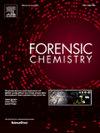Development and evaluation of a washing method for the removal of drugs infused on clothing
IF 2.2
3区 医学
Q2 CHEMISTRY, ANALYTICAL
引用次数: 0
Abstract
The presence of drugs, particularly new psychoactive substances (NPS), like synthetic cannabinoid receptor agonists (SCRAs) and novel benzodiazepines, infused in clothes sent to prisons necessitates the development of an effective and non-destructive removal method. The purpose of this study was to devise and assess a laboratory-scale washing method to effectively remove drugs infused in clothing. Small-scale laboratory experiments were performed on different textile types infused with a range of SCRAs commonly encountered within the Scottish Prison estate to test various washing conditions, including temperature, detergent types and concentrations. Large-scale laboratory experiments were performed to extend the applicability of the method to realistic scenarios. The study demonstrates that washing the infused clothes with a minimal amount of detergent currently used by the Scottish Prison Service (4–8 μg/mL) at 40 °C effectively removes up to 98 % of the drug compared to only about 28 % with water alone. Distinctive drug removal percentages were observed among different textile types, with cotton and wool exhibiting the highest drug removal percentage and polyamide and cotton-elastane the least. Drug transfer from infused to blank textiles was limited, with only a small fraction of the initial amount retained. The implications of this method can be applied to prisons worldwide, effectively mitigating drug-related issues and ensuring the safety of both prisoners and prison staff.

一种去除衣物上浸渍药物的洗涤方法的研制与评价
毒品的存在,特别是新的精神活性物质(NPS),如合成大麻素受体激动剂(scra)和新型苯二氮卓类药物,被注入监狱的衣服中,需要开发一种有效和非破坏性的清除方法。本研究的目的是设计和评估一种实验室规模的洗涤方法,以有效地去除衣物中注入的药物。在不同类型的纺织品上进行了小规模的实验室实验,这些纺织品注入了苏格兰监狱庄园中常见的一系列scra,以测试各种洗涤条件,包括温度、洗涤剂类型和浓度。进行了大规模的实验室实验,以扩展该方法在现实场景中的适用性。研究表明,用苏格兰监狱目前使用的少量洗涤剂(4-8 μg/mL)在40°C下洗涤注入的衣服,可以有效去除高达98%的毒品,而单独用水只能去除约28%的毒品。不同类型的织物对药物的去除率不同,棉花和羊毛的去除率最高,聚酰胺和棉弹性纤维的去除率最低。药物从注入到空白纺织品的转移是有限的,只保留了初始量的一小部分。这种方法的影响可以适用于世界各地的监狱,有效地减轻与毒品有关的问题,并确保囚犯和监狱工作人员的安全。
本文章由计算机程序翻译,如有差异,请以英文原文为准。
求助全文
约1分钟内获得全文
求助全文
来源期刊

Forensic Chemistry
CHEMISTRY, ANALYTICAL-
CiteScore
5.70
自引率
14.80%
发文量
65
审稿时长
46 days
期刊介绍:
Forensic Chemistry publishes high quality manuscripts focusing on the theory, research and application of any chemical science to forensic analysis. The scope of the journal includes fundamental advancements that result in a better understanding of the evidentiary significance derived from the physical and chemical analysis of materials. The scope of Forensic Chemistry will also include the application and or development of any molecular and atomic spectrochemical technique, electrochemical techniques, sensors, surface characterization techniques, mass spectrometry, nuclear magnetic resonance, chemometrics and statistics, and separation sciences (e.g. chromatography) that provide insight into the forensic analysis of materials. Evidential topics of interest to the journal include, but are not limited to, fingerprint analysis, drug analysis, ignitable liquid residue analysis, explosives detection and analysis, the characterization and comparison of trace evidence (glass, fibers, paints and polymers, tapes, soils and other materials), ink and paper analysis, gunshot residue analysis, synthetic pathways for drugs, toxicology and the analysis and chemistry associated with the components of fingermarks. The journal is particularly interested in receiving manuscripts that report advances in the forensic interpretation of chemical evidence. Technology Readiness Level: When submitting an article to Forensic Chemistry, all authors will be asked to self-assign a Technology Readiness Level (TRL) to their article. The purpose of the TRL system is to help readers understand the level of maturity of an idea or method, to help track the evolution of readiness of a given technique or method, and to help filter published articles by the expected ease of implementation in an operation setting within a crime lab.
 求助内容:
求助内容: 应助结果提醒方式:
应助结果提醒方式:


